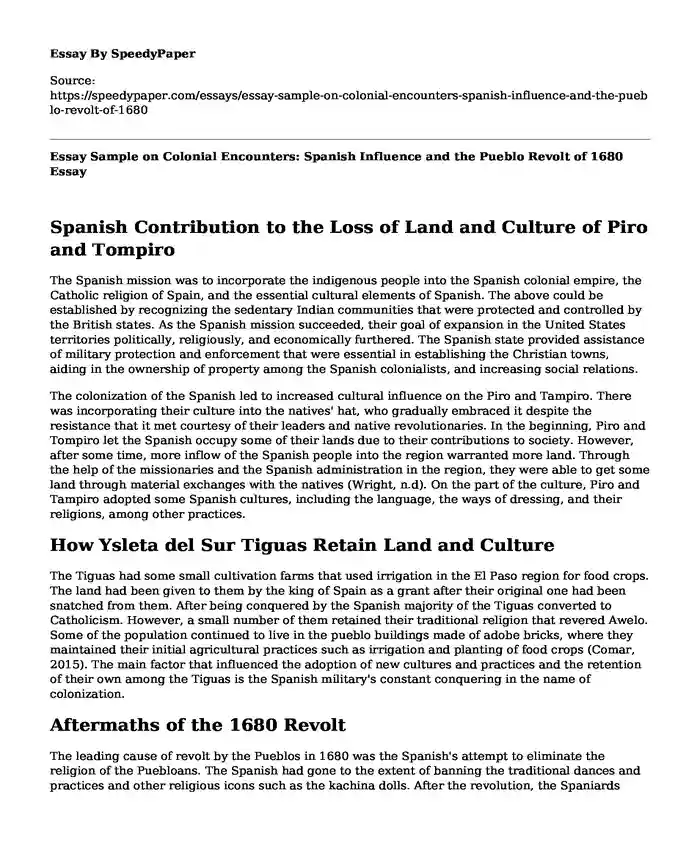Spanish Contribution to the Loss of Land and Culture of Piro and Tompiro
The Spanish mission was to incorporate the indigenous people into the Spanish colonial empire, the Catholic religion of Spain, and the essential cultural elements of Spanish. The above could be established by recognizing the sedentary Indian communities that were protected and controlled by the British states. As the Spanish mission succeeded, their goal of expansion in the United States territories politically, religiously, and economically furthered. The Spanish state provided assistance of military protection and enforcement that were essential in establishing the Christian towns, aiding in the ownership of property among the Spanish colonialists, and increasing social relations.
The colonization of the Spanish led to increased cultural influence on the Piro and Tampiro. There was incorporating their culture into the natives' hat, who gradually embraced it despite the resistance that it met courtesy of their leaders and native revolutionaries. In the beginning, Piro and Tompiro let the Spanish occupy some of their lands due to their contributions to society. However, after some time, more inflow of the Spanish people into the region warranted more land. Through the help of the missionaries and the Spanish administration in the region, they were able to get some land through material exchanges with the natives (Wright, n.d). On the part of the culture, Piro and Tampiro adopted some Spanish cultures, including the language, the ways of dressing, and their religions, among other practices.
How Ysleta del Sur Tiguas Retain Land and Culture
The Tiguas had some small cultivation farms that used irrigation in the El Paso region for food crops. The land had been given to them by the king of Spain as a grant after their original one had been snatched from them. After being conquered by the Spanish majority of the Tiguas converted to Catholicism. However, a small number of them retained their traditional religion that revered Awelo. Some of the population continued to live in the pueblo buildings made of adobe bricks, where they maintained their initial agricultural practices such as irrigation and planting of food crops (Comar, 2015). The main factor that influenced the adoption of new cultures and practices and the retention of their own among the Tiguas is the Spanish military's constant conquering in the name of colonization.
Aftermaths of the 1680 Revolt
The leading cause of revolt by the Pueblos in 1680 was the Spanish's attempt to eliminate the religion of the Puebloans. The Spanish had gone to the extent of banning the traditional dances and practices and other religious icons such as the kachina dolls. After the revolution, the Spaniards were forced to flee the region where 400 people had died, including over 20 priests. On the other hand, the Indians organized celebrations and festivals to express their victory by washing their hands to denounce Christian ways.
Such ways include baptism, the annulling of marriages established in a Christian way, and ended up destroying the churches, destroying anything related to the Spanish culture, including their livestock and the fruit trees. After the Spaniards' retreat, Pope was still a mysterious figure in the community who was entrusted by the Pueblos because of his sentiments. He seconded the Pueblos to dismiss their wives who had been married in the Catholic way instead of the traditional one and stopped planting wheat and barley. Despite the good things promised by the Pope, nothing was achieved, and even there was a drought that continued to destroy crops coupled with raids advanced by the Navajo and Apache on the Pueblos (Bletzer, 2013). Piro and Tompiro people do not exist in modern days. However, their ruins and remains were preserved in the Salinas Pueblo Mission National Monument.
References
Bletzer, M. (2013). " The First Province of that Kingdom": Notes on the Colonial History of the Piro Area. New Mexico Historical Review, 88(4).
Comar, S. C. (2015). The Tigua Indians of Ysleta Del Sur: A Borderlands Community. https://scholarworks.utep.edu/cgi/viewcontent.cgi?article=2022&context=open_etd
Wright, B. (n.d). Tigua Indians. Retrieved September 12, 2020, from https://www.tshaonline.org/handbook/entries/tigua-indians
Cite this page
Essay Sample on Colonial Encounters: Spanish Influence and the Pueblo Revolt of 1680. (2023, Dec 10). Retrieved from https://speedypaper.com/essays/essay-sample-on-colonial-encounters-spanish-influence-and-the-pueblo-revolt-of-1680
Request Removal
If you are the original author of this essay and no longer wish to have it published on the SpeedyPaper website, please click below to request its removal:
- Caring for People God's Way: Christian Counseling Essay Example
- Learning Kansas History Through Online Games, Essay Example
- Dialogue on the Problem of Evil - Paper Example
- Free Essay Example. Ethical Dilemma: Euthanasia
- Paper Sample: Gregory of Nyssa Reading Summary
- Organizational Culture Change and Employee Engagement Process - Free Essay
- Free Paper Example on Ecclesiology
Popular categories





